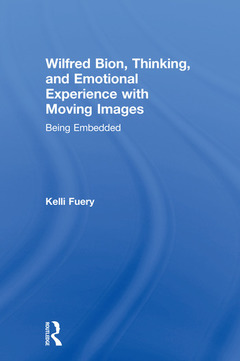Wilfred Bion, Thinking, and Emotional Experience with Moving Images Being Embedded
Auteur : Fuery Kelli

Wilfred Bion?s theories of dreaming, of the analytic situation, of reality and everyday life, and even of the contact between the body and the mind offer very different, and highly fruitful, perspectives on lived experience. Yet very little of his work has entered the field of visual culture, especially film and media studies. Kelli Fuery offers an engaging overview of Bion?s most significant contribution to psychoanalysis- his theory of thinking- and demonstrates its relevance for why we watch moving images.
Bion?s theory of thinking is presented as an alternative model for the examination of how we experience moving images and how they work as tools which we use to help us ?think? emotional experience. ?Being Embedded? is a term used to identify and acknowledge the link between thinking and emotional experience within the lived reception of cinema. It is a concept that everyone can speak to as already knowing, already having felt it - being embedded is at the core of lived and thinking experience. This book offers a return to psychoanalytic theory within moving image studies, contributing to the recent works that have explored object relations psychoanalysis within visual culture (specifically the writings of Klein and Winnicott), but differs in its reference and examination of previously overlooked, but highly pivotal, thinkers such as Bion, Bollas and Ogden. A theorization of thinking as an affective structure within moving image experience provides a fresh avenue for psychoanalytic theory within visual culture.
Wilfred Bion, Thinking, and Emotional Experience with Moving Images will appeal to psychoanalysts and psychoanalytic psychotherapists, as well as scholars and students of film and media studies, cultural studies and cultural sociology and anthropology, visual culture, media theory, philosophy, and psychosocial studies.
Chapter 1 Introduction
On ‘Being Embedded’
Different Psychoanalytic Thinking and Cognitive Film Studies
Embedded and Embodied: A Relational Distinction
Chapter 2 A Theory of Thinking for Moving Image Experience
Toward a (Meta)Theory of Thinking
From Drive to Feeling: Melanie Klein and Projective Identification
Satisfaction and Frustration: Bion’s Apparatus for Thinking
On the capacity to tolerate frustration
Chapter 3 Wandering Reverie and the Aesthetic Experience of Being Adrift 85
A note on wandering
Wandering as Reverie
Devious Journeying: Reverie and Spectatorship in Walkabout
Reverie as Spacings: The Irregular turning of aesthetic experience
The Affect of Spacing in Don’t Look Now
Aimless Passing: Being Embedded through Dreaming
Chapter 4 Metaphor, the Analytic Field, and the Embedded Spectator
Metaphor, 1970s Film Theory and Beyond
Antonino Ferro and Giuseppe Civitarese’s Metaphor within the Analytic Field
Analytic Field Theory and Field Theories of Cinema
The Embedded Spectator
Chapter 5 Group Experience, Collective Memory and Dreaming
Bion’s Experiences in Groups
The Task of the Group
Memory Work and Memory Texts: Force Majeure and Prisons Memory Archive
Immersion and Being Embedded with regard to Groups and Memory
Dreams and Memories
The relevance of Bion’s revision on dreaming
Chapter 6 Linking, Intentionality and the Container-Contained
Phenomenology: Experience, Consciousness, Intentionality
Husserlian beginnings and Casebier’s ‘in-between’ qualities
Sobchack’s Reversible Intentionality in Rabbit Proof Fence
Bion and Arendt: Linking, Emotion, and Thought
Cinema as Container-Contained
Container-Contained in Unforgiven
Chapter 7 Transformation: The Idiomatic Encounter and Use of Moving Image as Object
Bion’s Concept of O
The Importance of Invariance in Transformation
Antonioni’s Blow-Up
The Moving Image as Transitional and Transformational Object
An Aesthetic of Being: Westworld
Chapter 8 Being Embedded: Rhizome, Decalcomania and Containment
Reverie as Space and Rhizome
Rhizome
Decalcomania
Negative Capability
Time, Territory, and Surface
Containment
Boyhood
Kelli Fuery is Assistant Professor at Dodge College for Film and Media Arts, Chapman University, USA. She is the author of New Media: Culture and Image (2009) and co-author of Visual Cultures and Critical Theory (2003). She has also published widely on the themes of visual culture, psychoanalysis and critical theory.
Date de parution : 06-2018
15.6x23.4 cm
Date de parution : 07-2018
15.6x23.4 cm
Thème de Wilfred Bion, Thinking, and Emotional Experience with... :
Mots-clés :
Moving Image Experience; Bion; Bionian Field Theory; Object-relations; Bion’s Theory; psychoanalysis; Bionian Psychoanalysis; Wilfred Bion; Lived Emotional Experience; emotions; Analytic Field Theory; dreams; Transformative Self-experience; film; 1970s Film Theory; aesthetics; OED Definition; visual; Classical Psychoanalytic Models; Bollas; Moving Image Studies; Ogden; Psychoanalytic Film Theory; Film’s Story World; Acousmatic Sound; Aimless Passing; Guattari’s Rhizome; Cinematic Field; VR Experience; Vice Versa; Reversible Intentionality; Memory Work; Basic Assumption Mentalities; Object Relations Psychoanalysis; Binocular Vision; Christine’s Death



